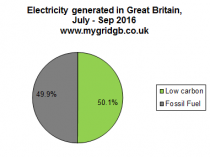It was reported in the Guardian newspaper that the UK hit a “clean energy milestone” after low carbon power “accounted for 50% of electricity generation in the UK in the third quarter”. This is based on Government figures here.
Is this true for Great Britain? Here are the numbers.
It was reported in the Guardian newspaper that the UK hit a “clean energy milestone” after low carbon power “accounted for 50% of electricity generation in the UK in the third quarter”. This is based on Government figures here.
Is this true for Great Britain? Here are the numbers.
In the period July – September 2016, 50.1% of the electricity generated in Great Britain was from low carbon sources (wind, nuclear, solar, hydroelectricity and biomass*) according to data from MyGridGB.

Over the whole year, low carbon generation was lower at 44.9%, in part due to high profile shutdown of nuclear plants and demand being higher in winter than summer.

However, what the figures reported by The Guardian miss are imports which have a significant impact. In July – September, Great Britain imported 7.3% of her electricity (the vast majority from France). That means that GB generated 46.5% of low carbon electricity within it’s shores BUT imported around 6.6% more low carbon electricity from France (at the time of writing 90% of French electricity was from nuclear and hydroelectric plants).
Over the year a similar picture emerges. Electricity is getting decarbonised, and maybe more than is reported.


So what can be concluded:
It is fair to say that low carbon sources provide a significant amount of electricity in Great Britain, but we must also remember to look at the wider picture. Where does our electricity come from? How much is imported? What timescales are we looking over?
And those questions are posed without considering where the 51.5% of our electricity from fossil fuels is imported from.
* Read more about biomass and carbon factors here.

